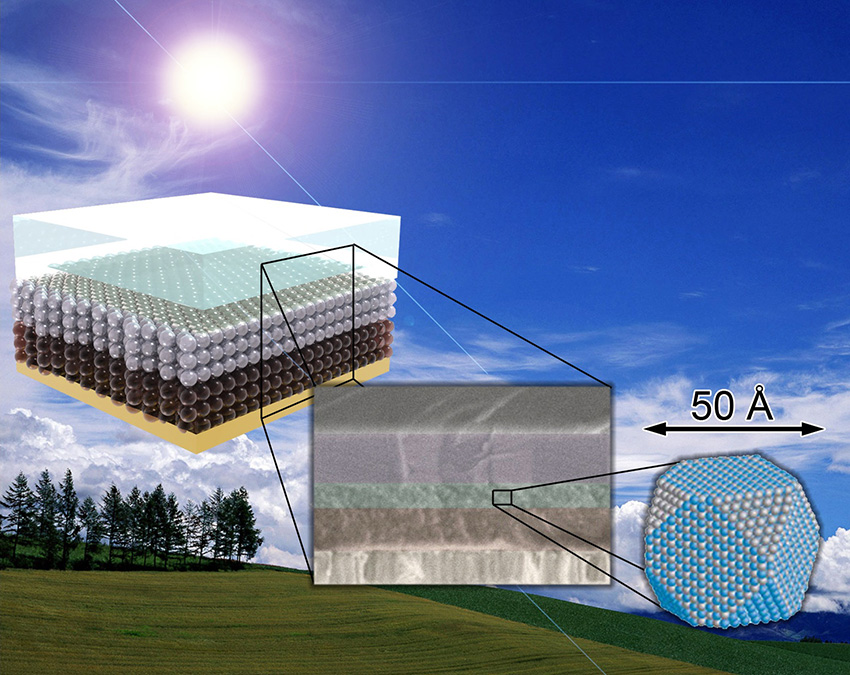Nanocrystal Solar Cells Squeeze Extra Juice Out of Sunlight
Laboratory measurements of “carrier multiplication” verified in real solar energy photovoltaic devices made of tiny quantum dots.

The Science
Careful spectroscopic measurements have produced a precise assessment of the true efficiency of “carrier multiplication,” a process in which a single photon of light creates more than one electron-hole pair in a semiconductor quantum dot. A quantum dot is only 10s of atoms across—and spatially confines the electron-hole pairs, leading to unique electronic properties. These measurements have now been verified quantitatively in actual photovoltaic devices made of lead-selenide quantum dots. The new devices have the potential for substantial improvements in performance compared to conventional photovoltaic cells.
The Impact
Third-generation solar photovoltaic technologies seek to use novel physical phenomena to achieve high efficiencies in low-cost devices. Carrier multiplication is a prominent example of such a phenomenon. This research proves that the excess charge carriers observed in lab experiments (using spectroscopic carrier-multiplication measurements) can actually be extracted as photocurrent in a real device, a seminal development for solar cell research.
Summary
Carrier multiplication (CM), also known as multiexciton generation (MEG), is a phenomenon whereby a single photon creates more than one electron-hole pair, which can boost the current in a solar cell. The development of quantum dot CM-enhanced solar cells has been frustrated by inconsistencies in measured CM efficiencies that thwart materials optimization efforts, and poor conductivity in quantum dot films that makes collection of the extra carriers inefficient. Recently, Center for Advanced Solar Photophysics (CASP) research at Los Alamos National Laboratory and the National Renewable Energy Laboratory has made key advances on both fronts. In parallel efforts, CASP spectroscopists established a rigorous and reproducible protocol for evaluating true CM efficiencies of different materials, while CASP synthesis researchers developed an effective methodology for fabricating device-grade highly conductive quantum dot films. These efforts culminated in the first exploratory solar cell to show an appreciable increase in current directly attributable to CM, in complete agreement with the spectroscopically determined efficiencies. This is a seminal achievement in the field of third-generation solar technologies, which seeks high efficiencies in low-cost devices through exploitation of novel physics such as CM.
Contact
Matthew Beard
Associate Director of CASP
National Renewable Energy Laboratory
matt.beard@nrel.gov
Victor Klimov
Director of CASP
Los Alamos National Laboratory
klimov@lanl.gov
Funding
DOE Office of Science, Basic Energy Sciences, Energy Frontier Research Centers (EFRC) program (spectroscopy at LANL and device assessment); DOE Office of Science Basic Energy Sciences Division of Chemical Sciences, Geosciences and Biosciences (CSGB) Solar Photochemistry program (spectroscopy at NREL); LANL Director’s Postdoctoral Fellowships (J.T.S and M.M.Q).
Publications
Semonin, Octavi Escala; Luther, Joseph M; Choi, Sukgeun; Chen, Hsiang-Yu; Gao, Jianbo; Nozik, Arthur J; and Beard, Matthew C Peak External Photocurrent Quantum Efficiency Exceeding 100% via MEG in a Quantum Dot Solar Cell, Science, 334, 1530-1533 (2011) [DOI: 10.1126/science.1209845].
Stewart, John T.; Padilha, Lazaro A.; Qazilbash, M. M.; Pietryga, Jeffrey M.; Midgett, Aaron G; Luther, Joseph M; Beard, Matthew C; Nozik, Arthur J; and Klimov, Victor I. Comparison of carrier multiplication yields in PbS and PbSe nanocrystals: The role of competing energy-loss processes, Nano Lett., 12, 622–628 (2011). [DOI: 10.1021/nl203367m]
Related Links
http://science.energy.gov/discovery-and-innovation/stories/2012/127026/
http://www.nrel.gov/news/press/2011/1667.html
http://www.electronicsnews.com.au/news/quantum-dot-solar-cells-can-exceed-100-percent-con
http://www.azoquantum.com/news.aspx?newsID=155
http://science.energy.gov/bes/efrc/centers/casp/
http://www.centerforadvancedsolarphotophysics.org/
Highlight Categories
Performer: DOE Laboratory
Additional: Technology Impact



